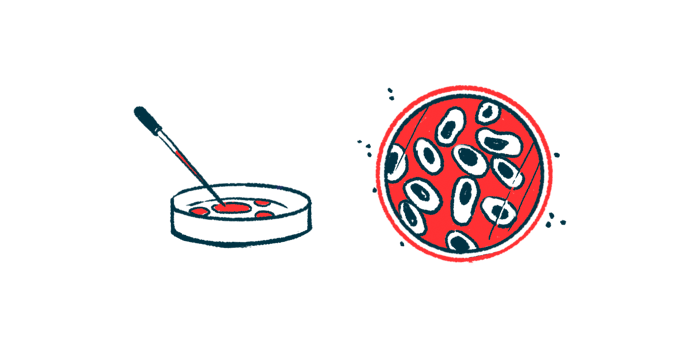Rare cell type in lungs found to regulate airway liquid pH
Cell-based study's findings could lead to new types of treatment for CF

Pulmonary ionocytes, a rare airway cell type that produces high levels of CFTR — the protein that’s defective in cystic fibrosis (CF) — were found to regulate the acidity of the liquid coating the surface of the airways, a cell-based study showed.
Results also showed that club cells, another type of cell that lines the airways, produce and release the bulk of the airway fluid.
“In CF, abnormal ionocyte and club cell function results in acidic and dehydrated [airway surface liquid], causing reduced antimicrobial properties and mucociliary clearance,” the researchers wrote.
According to the team of scientists, from the University of Saskatchewan (USask), in Canada, the findings of this work could lead to new types of treatment for CF.
“It’s been shown that abnormal airway acidity is an important component of CF lung disease pathobiology [biological mechanisms],” Julian Tam, MD, one of the study’s authors from USack, said in a university press release. “What we found is that pulmonary ionocytes regulate the acidity of CF airways.”
The cell-based study, “Pulmonary Ionocytes Regulate Airway Surface Liquid pH in Primary Human Bronchial Epithelial Cells,” was published in the American Journal of Respiratory and Critical Care Medicine.
Seeking to determine the airway cell type involved in CF disease mechanisms
CFTR is a protein that extends across cell membranes, where it acts as a gate that controls the flow of water and chloride ions in and out of cells. In CF, mutations in the CFTR gene cause the CFTR protein to be defective or missing altogether. This, in turn, disrupts the balance of water and salt and leads to the buildup of thick and sticky mucus, especially in the lungs.
Various types of cells, called epithelial cells, line the airways, but it remains unclear which specific type is involved in the defective chloride ion flow and mucus clearance that characterize CF.
Airway cells include club and basal cells, which are precursor cells that give rise to other cell types. Ciliated cells with brush-like protrusions help move mucus and keep the airways clean. Other types include secretory goblet cells, the lungs’ primary mucus producers, and tuft cells, with sensory functions.
In recent years, a previously unknown type of cells, called pulmonary ionocytes, was discovered. Although they make up only about 1% of the total number of airway cells, pulmonary ionocytes have the highest CFTR gene expression, or activity. This is indicated by the levels of its messenger RNA — a template molecule cells use for protein production that’s derived from DNA.
“This minute population of cells express most of the RNA for CFTR,” said Juan Ianowski, PhD, a professor at USask’s College of Medicine and one of the study’s authors.
He added: “It’s a very difficult thing to study because how do you study 0.5 per cent of the entire epithelia?”
Gene therapy treatments, if they work and we have a systematic way of developing them, it’s a game changer for this and other diseases as well.
Some evidence suggests that ionocytes are involved in CFTR-mediated chloride transport, which influences the water/salt balance on airway surfaces, or airway surface liquid (ASL). Other evidence indicates that club cells, not ionocytes, are the main cell type involved in CF.
These contradictory findings may limit the development of therapies for CF, such as gene therapy, that require a precise identification of cellular targets.
“Gene therapy treatments, if they work and we have a systematic way of developing them, it’s a game changer for this and other diseases as well,” Ianowski said.
Researchers investigated disease mechanisms at single-cell level
To resolve this controversy, the team examined the ion transport properties of pulmonary ionocytes and club cells at the single-cell level, using human bronchial epithelial cell cultures from CF and non-CF donors.
According to Tam, “one of our lab’s tools is a specialized technique that allows us to study cells at a single-cell level.”
“We think it’s important to correct the appropriate cells for gene therapies, so having an understanding of which cells have which function would allow researchers to do this,” Tam said.
First, the researchers stimulated CFTR-mediated ion transport and then measured the flow of ions, including chloride, sodium, and hydrogen. , pH is defined as the concentration of hydrogen ions, with low pH values signaling the presence of a higher number of hydrogen ions and increased acidity.
Measurements showed that non-CF ionocytes did not secrete, or release, sodium or chloride into the ASL.
Still, the total and maximum flow of chloride and hydrogen ions was significantly higher in non-CF than in CF cells. Treating CF ionocytes with a combination of three CFTR modulators, a class of medicines that correct CFTR protein defects, resulted in a recovery of hydrogen and chloride transport.
Instead, ionocytes appeared to modulate the pH of the ASL by secreting bicarbonate ions via CFTR-linked exchange between chloride and bicarbonate.
“These results suggest CFTR is indeed involved in bicarbonate secretion by ionocytes,” the researchers wrote.
Stimulation of non-CF club cells, however, resulted in a large increase in sodium and chloride flow into the ASL. Again, both total and maximum sodium and chloride flow were significantly higher in non-CF club cells than in CF cultures, which was “consistent with the hypothesis that CF airways have reduced ASL formation,” the team wrote.
As in ionocytes, treatment with the CFTR modulators restored sodium and chloride transport in club cells.
“Our results indicate ionocytes and club cells have different and specific functions in maintaining ASL integrity,” the researchers wrote. “The function of multiple cell types may need to be restored to achieve healthy ASL.”









